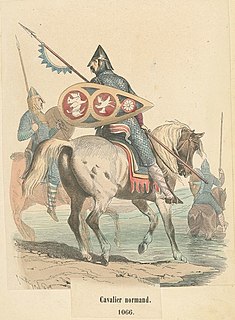
Year 1040 (MXL) was a leap year starting on Tuesday of the Julian calendar.

Year 1041 (MXLI) was a common year starting on Thursday of the Julian calendar.

George Maniakes was a prominent general of the Byzantine Empire of Armenian origin during the 11th century. He was the catepan of Italy in 1042. He is known as Gyrgir in Scandinavian sagas. He is popularly said to have been extremely tall and well built, almost a giant.

The Varangian Guard was an elite unit of the Byzantine Army from the tenth to the fourteenth century. The members served as personal bodyguards to the Byzantine emperors. The Varangian Guard was known for being primarily composed of recruits from northern Europe, including mainly Norsemen from Scandinavia but also Anglo-Saxons from England. The recruitment of distant foreigners from outside Byzantium to serve as the emperor's personal guard was pursued as a deliberate policy, as they lacked local political loyalties and could be counted upon to suppress revolts by disloyal Byzantine factions.

The Battle of Dyrrhachium took place on October 18, 1081 between the Byzantine Empire, led by the Emperor Alexios I Komnenos, and the Normans of southern Italy under Robert Guiscard, Duke of Apulia and Calabria. The battle was fought outside the city of Dyrrhachium, the major Byzantine stronghold in the western Balkans, and ended in a Norman victory.

The Catepanateof Italy was a province of the Byzantine Empire from 965 until 1071. At its greatest extent, it comprised mainland Italy south of a line drawn from Monte Gargano to the Gulf of Salerno. Although north of that line, Amalfi and Naples maintained allegiance to Constantinople through the catepan. The Italian region of Capitanata derives its name from katepanikion.
Argyrus was a Lombard nobleman and Byzantine general, son of the Lombard hero Melus. He was born in Bari.
Rainulf Drengot was a Norman adventurer and mercenary in southern Italy. In 1030 he became the first count of Aversa. He was a member of the Drengot family.
Melus was a Lombard nobleman from the Apulian town of Bari, whose ambition to carve for himself an autonomous territory from the Byzantine catapanate of Italy in the early eleventh century inadvertently sparked the Norman presence in Southern Italy.

Basil Boioannes, called Bugiano in Italian, was the Byzantine catapan of Italy and one of the greatest Byzantine generals of his time. His accomplishments enabled the Empire to reestablish itself as a major force in southern Italy after centuries of decline. Yet, the Norman adventurers introduced into the power structure of the Mezzogiorno would be the eventual beneficiaries.
Arduin the Lombard was a Greek-speaking Lombard nobleman who fought originally for the Byzantines on Sicily and later against them as the leader of a band of Norman mercenaries.
Michael Dokeianos, erroneously called Doukeianos by some modern writers, was a Byzantine nobleman and military leader, who married into the Komnenos family. He was active in Sicily under George Maniakes before going to Southern Italy as Catepan of Italy in 1040–41. He was recalled after being twice defeated in battle during the Lombard-Norman revolt of 1041, a decisive moment in the eventual Norman conquest of southern Italy. He is next recorded in 1050, fighting against a Pecheneg raid in Thrace. He was captured during battle but managed to maim the Pecheneg leader, after which he was put to death and mutilated.
The Battle of Cannae was a battle that took place in 1018 between the Byzantines under the Catepan of Italy Basil Boioannes and the Lombards under Melus of Bari. The Lombards had also hired some Norman cavalry mercenaries under their leader Gilbert Buatère, while Boioannes had a detachment of elite Varangian Guard sent to him at his request to combat the Normans.
Hugh Tubœuf or Tudebusis was a Norman adventurer who went to Southern Italy around 1030 in search of glory and riches.
Exaugustus Boiοannes, son of the famous Basil Boioannes, was also a catepan of Italy, from 1041 to 1042. He replaced Michael Dokeianos after the latter's disgrace in defeat at Montemaggiore on May 4. Boioannes did not have the levies and reinforcements that Doukeianos had had at his command. He arrived only with a Varangian contingent. Boioannes decided on trying to isolate the Lombard rebels in Melfi by camping near Montepeloso.
Dattus was a Lombard leader from Bari, the brother-in-law of Melus of Bari. He joined his brother-in-law in a 1009 revolt against Byzantine authority in southern Italy.

The Norman conquest of southern Italy lasted from 999 to 1139, involving many battles and independent conquerors.

The Battle of Olivento was fought on 17 March 1041 between the Byzantine Empire and the Normans of southern Italy and their Lombard allies near the Olivento river, between the actual Basilicata and Apulia, southern Italy.
The Battle of Montepeloso was fought on 3 September 1041 between Lombard-Norman rebel forces and the Byzantine Empire, near Montepeloso in southern Italy. The Byzantines, led by Exaugustus Boioannes, were forced into battle by the rebels, and after a day-long fight the rebels defeated the Byzantine army and captured Boioannes. The decisive rebel victory forced the Byzantines to retreat to the coastal cities, leaving the Normans and Lombards in control of the whole interior of southern Italy.
The Battle of Larissa was a military engagement between the armies of the Byzantine Empire and the Italo-Norman County of Apulia and Calabria. On 3 November 1082, the Normans besieged the city of Larissa. In July of the following year, Byzantine reinforcements attacked the blockading force, harassing it with mounted archers and spreading discord among its ranks through diplomatic techniques. The demoralized Normans were forced to break off the siege.










